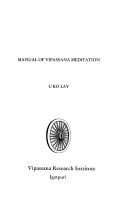The Secrets of Chinese Meditation 0877280665
296 102 10MB
English Pages 260 Year 1972
The Secrets Of Chinese Meditation
TOC
Illustrations
Sakyamuni Buddha
Mater Hsu Yun
Three Holy Ones Of The Western Paradise
Preface
1. Self-cultivation as taught in the Surangama Sutra
A. Meditation On The Six Sense Data
1. Meditation on sound
2. Meditation on form
3. Meditation on smell
4. Meditation on taste
5· Meditation on touch
B. Meditation On The Five Sense Organs
6. Meditation on things ( dharma)
7. Meditation on the organ of sight
8. Meditation on the organ of smell
9. Meditation on the organ of taste
10. Meditation on the body
11. Meditation on the intellect {manas)
C. Meditation On The Six Consciousnesses
12. Meditation on sight perception
13. Meditation on ear perception
14. Meditation on smell perception
15. Meditation on tongue perception
16. Meditation on the perception of objects of touch
17. Meditation on the faculty of mind {mano-vijfiana)
D. Meditation On The Seven Elements
18. Meditation on the element fire
19. Meditation on the element earth
20. Meditation on the element water
21. Meditation on the element wind
22. Meditation on the element space
23. Meditation on the element consciousness
24. Meditation on the element perception
25. Meditation on the organ of hearing
2. Self-cultivation according to the Chan (Zen) School
The Mind Dharma Or Doctrine Of The Mind
The Inner Potentiality
The Ancient Technique
The Kung An Device
The Hua T'ou Technique
I Ch'ing Or The Feeling Of Doubt
Instructions By Enlightened Masters
1. Instruction given by the late Master Hsu Yun (1 840-1959)
2. Instruction given by Master Han Shan (1546-1623)
(a)
(b)
(c)
(d)
3. Instructions given by Master Kao Feng (1238-1295)
4. Instruction given by Master Chrmg Feng (1263-1323)
(a) To upasaka Hai Yin
(b) To the Japanese ascetic Ting I (Tei-ichi)
5. Instruction given by Master Ta Kuan, alias Tsu Pai (1 543-1004)
Freezing The Wandering Mind For The Resurrection Of Self-Nature
Relative Nirvana
The Yun Men Dharma (Ummon Zen)
The Linchi Dharma (Rinzai Zen)
The Kuei Yang Dharma (Ikyo Zen)
The Ts'ao Tung Dharma (Soto Zen)
The Fayen Dharma (Hogen Zen)
Asolute Nirvana
The Final Sentence
Bodhi Or Enlightenment
3. Self-cultivation according to the Pure Land School
The Lineage Of The Pureland school
Methods Of Practice
1. Repetition of Amitabha's Name.
2. Repetition of the Mantra of Amitabha
3. The Contemplation of Amitayus Buddha
1. Contemplation Of The Setting Sun
2. Contemplation Of Water
3. Contemplation Of The Ground
4. Contemplation Of Precious Trees
5. Contemplation Of Merit-Giving Water
6. Contemplation Of The Realm Of Bliss
7. Contemplation Of The Lotus Seat
8. Contemplation Of The Images Of The Three Holy Ones
9. Contemplation Of The Bodily Form Of Amitayus Buddha
10. Contemplation Of Avalokitesvara Bodhisattva
11. Contemplation Of Mahasthama Bodhisattva
12. Contemplation Of Amitayus' Realm Of Bliss
13. Contemplation Of The Three Holy Ones
14. The Superior Class Of Birth In The Realm Of Bliss
15. The Middle Class Of Birth In The Realm Of Bliss
16. The Inferior Class Of Birth In The Realm Of Bliss
4. Self-cultivation according to the Tien Tai School
(I) Samatha-Vipasyana For Beginners
1. Formation Of Concurrent causes
2. Rebuking All Desires
3. Removal Of Screens
4. Regulating Food , Sleep , Body, Breathand Mind
5. Expedient Lines Of Conduct
6. The Main Practice
7. Manifestation Of Goodroots (Qualities)
8. Discerning Mara's Harmful Interference
9. The Healing Of Ailments
10. The Final Realization
The Chih-Kuan Dharma Door
(II) The Six Profound Dharma Doors
5. Self-cultivation according to the Taoist School
A. Regulating The Bodily Posture
1. Before and after the meditation
2. The position of the legs
3. The chest, buttocks and belly
4. The two hands
5. The face, ears, eyes, mouth and breath
6. The mental state during meditation
7. The duration of meditation
B. Regulating The Breath
1. Natural breathing
2. Correct breathing
3. The breathing exercise
C. Vibration In The Belly
D. My Personal Experience
1. My childhood
2. My youth
3. My motive for meditating.
4. Resumption of my practice of meditation
5. Time-table for my meditation
6. Difficulties at the beginning of my practice
7. The first vibration
8. The second and third vibrations
9. Over twenty years' experience.
10. The secret of 'forgetfulness'
11. Avoidance of impatience for quick results
12. Vibration bearing no relation to the effectiveness of meditation
13. Relation between meditation and sleep
14. Relation between meditation and food
Question.
6. Authentic experiments with Buddhist and Taoist methods of self-cultivation
7. Physical and spiritual culture according to Chinese Yoga
The Microcosmic Orbit Technique
Self-Healing
A Substitute For Daily Walking
Inner Organ Invigorating Yoga
The Taoist Secret Of The Sixhealing Sounds
Ancient Medical Science
Acupuncture And Cauterization
Spirit Over Matter
Rejuvenation And Immortality
Omnipresence And Omniscience
Conclusions
Glossary
Index
Recommend Papers

- Author / Uploaded
- Charles Luk
- Lu Kuan Yü
File loading please wait...
Citation preview
e meditation : self The secrets of Chines 13209 BL1478.6 .L8 1972 Bl
Lu,
\ \11\1111111 \\\II \II\ 11\11 \�\\Ill
K'uan Yu,
IFORNIA (SF) NEW COLLEGE OF CAL
Lu,
BL
K'uan Yu.
The secrets of Chines�
1478.6 LB 1972
I
meditation.
6010 DATE DUE
DEC 6 ·9;
ROOM NUMBER.
BORROWER'S NAME
i I
/,......
I
I I
I I
I
I
I I
#6010 BL 14'78.6 LS 19'72
1898, Lu, K'uan Yu tation : C hinese me di o1 s The secr et contro�· as tion by mind va ti u� -c �1 se yana. and TaoJ.st e Ch1 a n lla.ba. th in · ht ug ta n Yu (Cbar�es ina I Lu K1ua Ch in s o� ho sc 19"12· rk : Weiser, Luk)• New Yo • ; 22 cm 240 P• : i��. rences raph1ca� re1e ' og �i b Inc�udes bi an d index• tmey er $3e50• #6010 Gi1t:Whi
en Meditation (Z • na. hi -C 2. Buddhlsme t� Ti le (Taoism)
1.
Buddhism) 3. Meditat1on
(
06 DEC
84
818313
NEWCxc
� USR"-RY CAL1f .,. 'CT 0 U£GE o F_ NEW co �· ALf.NClA ST 111 v Mllt ClSco • CA SAN fR,AN 9't ·,41s1 &2s-1&
THE SECRETS OF CHINESE MEDITATION DATE DUE Ott 6 '92
I
I !
45230
Printed In USA .
By the same author CH.AN AND ZEN TEACHING Series I Series II Series III
LIBRARY
CALIFORNIA STREET
NEW COILEGE OF 777 VALENCIA SAN
FRANCISCO. CA Mllt
l-415) G26-16H
The body of Ch'an Master Wen Yen, founder of the Yun Men sect at Yun Men monastery, Kwangtung province, China. (Died in
949)
LU K'UAN
YU
(Charles Luk)
THE SECRETS OF CHINESE MEDITATION
�t��ti;nby�d c�1�[���� Ch'an, Mahayana and Taoist schools in China
SAMUEL WEISER New York
1972
First Published by Rider & Co. 1964 This American Edition 1969 Second Impression 1971 Third Impression l 972
©Charles Luk 1964 ISBN 0-87728-066-5 All rights reserved.
SAMUEL WEISER, INC. 734 Broadway New York, N. Y. 10003
Printed in U.S.A. by NOBLE OFFSET PRINTERS, INC. New York, N.Y. 10003
'4#P-
To the memory of c ARL Gus TA v J uNG
and L 0 B z ANG JI v AK A
whose encouragement has sustained my humble efforts to present to Western Buddhists the Dharma as taught in my country
CONTENTS
Preface
II
I
Self-cultivation as taught in the Siirangama Siitra
IS
2
Self-cultivation according to the Ch'an (Zen) school
43
3
Self-cultivation according to the Pure Land school
8I
4
Self-cultivation according to the T'ien T'ai (Tendai) school
I09
s
Self-cultivation according to the Taoist school
I6 3
6
Authentic experiments with Buddhist and Taoist methods of self-cultivation
I9I
Physical and spiritual culture according to Chinese yoga
205
7
Conclusion Glossary Index
2IS 2I9 23 3
ILL USTRA TIONS
The body of Master Wen Yen
ftontispiece
1
Sakyamuni Buddha
16
2
The late Ch'an Master Hsu Yun in 1959
48
3
The three Holy Ones of the Western Paradise
So
PREFACE
We take refuge in the Buddha, We take refuge in the Dharma, We take refuge in the Sangha, We take refuge in the Triple Gem within ourselves. THE Buddha Dharma is useless if it is not put into actual practice because if we do not have personal experience of it, it will be alien to us and we will never awaken to it in spite· of our book-learning. An ancient said:
Self-cultivation has no other method, It requires but knowledge of the way. If the way only can be known, Birth and death at once will end. Therefore, in our self-cultivation, we should first know the way, and the Buddhas and great masters have taught us the appropriate methods in the sutras and treatises. The purpose of this volume is to acquaint readers with various methods of meditation as practised in China so that they can choose any one of them for their self-cultivation. At first we hesitated to present versions of Chinese texts on successful practices and on experiences of dhyana as we have been criticized for being unduly optimistic about the future of II
12
PREFACE
the Buddha Dharma in the West. Fortunately, a learned reader of ours, Mr. Terence Gray, who recently paid a short visit to the Far East, has written us: 'I myself believe that even if it
were true that the East is weary after a thousand years of efforts, those of the West are as fresh today as were the dis ciples of Hui Neng.' He has also kindly sent us a copy of
Mr. D. E. Harding's little book entitled On having no Head1 in which the author relates his personal experience of dhyana. We are grateful to Mr. Gray for the encouraging news and to
Mr. Harding for his book and have thus been emboldened to present in this volume different methods of meditation
with the accounts of satisfactory results achieved by some pracusers.
The Buddha Dharn1a has no room for race and nationality and nothing is more misleading than the groundless contention
that Westerners are not fit to achieve enlightenment. In their former lives many were virtuous men and women who
practised the Buddha's Teaching but failed to attain enlighten ment; their good karmas have caused them to be reborn in countries where propitious conditions prevail so that they can resume their self-cultivation. Those who have been reborn in the West are capable of understanding the holy Teaching
and will certainly achieve satisfactory results in their present
life. Therefore, racial discrimination should be cast away for Lin Chi said: 'There is not a living being who cannot be liberated.'2 Buddhism is in decline in the East because of the division of the Dharma into different schools contradictory and hostile to each other. There are people who, instead of practising the methods taught in the sutras and treatises, indulge in endless discussions which are empty and give no practical results. Others only learn to recite the sutras by heart without striving to understand their profound meanings. Many are those who worship the Buddha, recite sutras and repeat mantras in the I. The Buddhist Society, London, 1 961.
2. See Ch'an and Zen Ttaching, Second Series, Rider (1961), p. u3.
PRBFACE
13
hope of reaping merits for themselves and their families, with out knowing that the World Honoured One teaches us to keep from illusions but not to cling to merits which are also illusory. We are urged by Him to forsake the cult of ego, then what
merit do we earn when we cease to be selfish? What merit can a thief win when he stops stealing? There are also those who, in their study of Sanskrit and Tibetan, pass their precious time in practising the correct pronunciation either by pressing down the tongue or by putting it up against the palate or between the teeth, not realizing that philology has nothing to do with self cultivation. Our modern students of siitras and treatises, in stead of studying their profound meanings, seem to be more
interested in obtaining historical, linguistic and geographical data which have nothing to do with the Buddha Dharma which is beyond space and time. During the last few years, in spite of my secluded life, I have met �ome of my readers in the West and have received very encouraging letters from others, and I have come to the con clusion that many Occidentals are now mature and digest quite well the Mahayana and Ch'an Teachings. At least half a dozen of them have related their personal experience of the state of dhyana, amongst whom are two British readers in America. My optimism about the future of the Dharma in the West is, therefore, not groundless. To prevent disbelief in the involuntary movements de scribed in Chapters 6 and 7, I have given a sixty-five-minute demonstration of them to two British Bhikkhus, the Ven. Khema and the Ven. Aruno who are graduates of Oxford and Cambridge respectively and who happened to be in Hong Kong. The Ven. Aruno is Mr. Harding's son. Before their arrival, I gave the same demonstration to Mr. Hugh Ripman, a British banker, Mr. Paul H. Beidler, an American engineer, Dr. Huston Smith, professor of philosophy, Massachusetts Institute of Technology, Mr. Holmes Welch, author of The Parting of the Way, Madame Maurice Lebovich, a French painter, and a few well-known Chinese Buddhists, including
14
PRBFACB
Mr. K. S. FWlg, chief delegate of the Chinese Buddhists of the Hong Kong-Macao area at the Sixth Congress of the World Fellowship of Buddhists at Pnompenh, Cambodia, in 1961.
All brackets are mine. Hong Kong.
UPASAKA LU K'UAN YU
THE SECRETS OF CHINESE MEDITATION
I
SELF-CULTIVATION AS TAUGHT IN THE SORANGAMA SOTRA-
ACCORDING to the Buddha, we all have inherent in ourselves
the Tathagata's wisdom which is unknown to us and which we cannot use because of our ignorance. We are also taught how
to control our wandering minds so that our self-nature can return to its normal condition by which is meant a passionless, still and imperturbable state, free from all external influences, in which our immanent wisdom can manifest and function in the normal way, that is the way of the absolute, beyond all relativities and contraries. Therefore, when discussing self-cultivation, we cannot stray from the Buddha Dharma for the World Honoured One taught us how to get out of sarhsara for ever, whereas the highest achievement by other religious doctrines is only a temporary transmigration to the happy realm of devas from which, when the benefit of our good karma has beeh enjoyed to the full, we will be sent down again to the lower worlds of existence. For this reason, Yung Chia urged us not to seek happiness in sarhsara and wrote in his Song of Enlightenment:
With force expended, a spent arrow's bound to fall and cause Distasteful things to follow in the next incarnation. How can it then compare with the wu wei reality Which ensures a leap straight to the Tathagata's stage?1 I. See
Ch'an and Zen Teathing, Third Series, Rider
IS
(1962), p.
127.
16
THE SECRETS OP CHINESE MED IT ATI ON
As regards self-cultivation, there are many methods of practice which are found in the Chinese siitras and sastras but it is a matter for regret that authentic versions in Western
languages are not yet available. Although we Buddhists in the East have access to the Chinese Tripi�aka, it is impossible for us to practise all the methods simultaneously or one after the
other in our quest of enlightenment (bodhi). In China, many
Buddhists fail in self-cultivation because they choose wrongly methods unsuitable for them. For this reason, the late Master Hsu Yun said at the Jade Buddha monastery at Shanghai a few years ago:
Self-cultivation has no other method; It requires but knowledge of the way.1 Because of His great compassion for all living beings whom He vowed to save, and in anticipation of our present confusion
and perplexity in this Dharma ending age, the Buddha com manded twenty-five great Bodhisattvas and Arhats who were present in the Siirangama assembly to speak of their methods of practice and of their personal experiences. The Siirangama Siitra lists twenty-five ways of controlling the mind by meditation on the six sense data, six sense organs, six consciousnesses and seven elements-earth, water, fire, wind,
space, sense-perception and consciousness. After each of the twenty-five great ones had related his personal experience and achievement, the Buddha ordered Manjusri to compare their methods and to indicate the one most suitable for the benefit of Ananda and those in the Dharma ending period, that is ourselves. After rejecting the twenty-four methods which were not suitable for untrained minds, Manjusri chose the one followed by Avalokitdvara, which he praised as the most convenient for people on this earth. It consisted in disengaging the organ of hearing from its object, sound, and then directing that I.
See Ch'an and Zen Teaching, First Series, Rider (1960), p. 62.
., '" ,.., iJ
>'>'
�;..
1
Sakyamuni Buddha
SELF-CULTIVATION .
.
. SURANGAMA SUTRA
17
organ into the strea1n of concentration. When the conception of both sound and stream-entry had been successfully wiped out, the duality of disturbance and stillness became illusory and non-existent. By advancing step by step, the subjective hearing and objective sound also vanished completely. This was where many meditators lost their way and were turned back to the realm of birth and death, but Avalokitdvara said he did not stop there but strove to advance further. When the subjective awareness of this state and its object, that is the state itself, were perceived as illusory and non-existent, the awareness of voidness became all-embracing. However, the finest duality of subject and object, in other words the subtle view of ego and things (dharma), mentioned in the Diamond Siitra, still remained and when this also was eliminated, this Bodhisattva reached the absolute state wherein all pairs of opposites, such as birth and death, creation and annihilation, beginning and end, ignorance and enlightenment, Buddhas and living beings, etc., have no room. Then the condition of nirva�a appeared, followed by a sudden leap over both the mundane and supramundane for realizing Absolute Universal Enlightenment (for the self ) and Wonderful Englightenment (for others).1 Here are the relative passages in the Siirati.gama Siitra: 'The World Honoured One said to the great Bodhisattvas and chief Arhats in the assembly: "I want now to ask you, Bodhisattvas and arhats who have practised my Dharma and have reached the state beyond study,2 this question: When you developed your minds for awakening to the eighteen realms of sense (dhatu),3 which one did you regard as the best means of perfection and by what methods did you enter the state of samadhi l°'' 1. Respectively the fifty-first and fifty-second stages of a Bodhisattva's development into a Buddha. 2. Afaik�a in Sanskrit; no longer learning, beyond study, the state of arhatship, the fourth of the sravaka stages; the preceding three stages requiring study. When an arhat is free from all illusions, he has nothing more to study. 3. Realms of sense, i.e. the six organs, their objects and their perceptions. 4. Internal state of imperturbability, exempt from all external sensations.
I8
THE SECRET S OF CHINESE MEDITATION
A.
I.
MEDITATION ON THE SIX SBNSE DATA
Meditation on sound
'(Thereupon), KauI).









